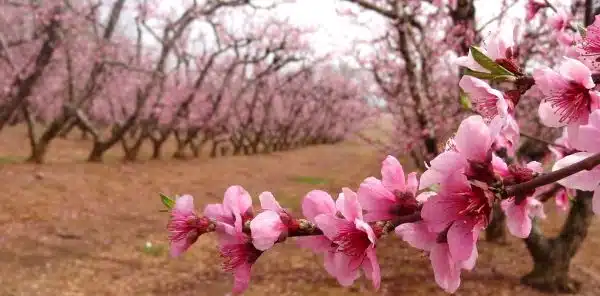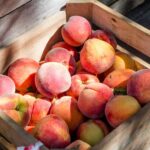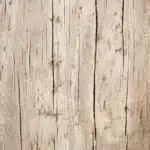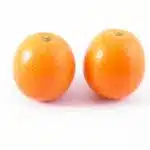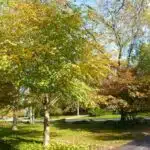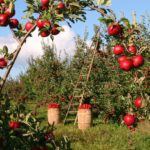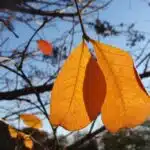Peach trees are a popular and beloved fruit tree for many gardeners and orchard owners. However, to ensure the health and productivity of these trees, it is important to properly prune them. Pruning peach trees not only helps with fruit production but also enhances the overall health of the tree by removing diseased or damaged branches.
Pruning is a horticultural practice that involves selectively removing parts of a plant to improve its shape, structure, and growth. Peach trees require regular pruning, which can be done in the winter months when they are dormant or during early spring before new growth begins. Proper pruning techniques include removing dead, diseased, or damaged branches as well as thinning out overcrowded areas to allow for more sunlight penetration and airflow. In this article, we will discuss how to properly prune peach trees to optimize their health and productivity.
Understanding The Importance Of Pruning For Peach Trees
Peach trees are like the human body – they need proper maintenance to thrive. One of the most important practices that should be done regularly is pruning. This is a horticultural technique that involves removing certain parts of a tree to improve its overall health and productivity. Pruning is highly beneficial for peach trees, as it allows them to produce better quality fruits while preventing diseases and pests from taking over.
The benefits of pruning are numerous. For one, it promotes the growth of new branches, which in turn leads to more fruit production. Additionally, pruning helps maintain the shape and size of the tree, making it easier to manage and harvest. Proper pruning techniques also ensure that sunlight can penetrate through the canopy, reaching all parts of the tree equally. This results in better air circulation and less humidity, reducing the risk of fungal infections.
When it comes to pruning peach trees, there are several techniques that one must learn. The first is called thinning, which involves removing some branches entirely to avoid overcrowding and competition for nutrients. The second technique is called heading back, which entails cutting off part of a branch to stimulate new growth. Lastly, there’s shaping or training, which requires careful selection of branches that will form the structure of the tree over time.
Identifying the best time to prune your peach trees is crucial for their success. In the next section, we will discuss how you can determine when exactly you should prune your trees depending on their age and stage of development.
Identifying The Best Time To Prune Your Peach Trees
Understanding the importance of pruning for peach trees is vital to their overall health and productivity. Pruning helps to remove damaged or diseased branches, encourages new growth, and improves air circulation throughout the tree. However, it is essential to prune at the right time to avoid unnecessary stress on the tree.
Identifying the best time to prune your peach trees depends on several factors. The most important factor is the tree’s growth stage. Pruning during dormancy, before bud break in early spring, is recommended as it allows for easy access to all parts of the tree without damaging new growth. Late summer or fall pruning can also be done but should only involve light trimming.
Pruning frequency plays a crucial role in the impact on fruit production. Annual pruning is recommended for younger trees to encourage strong branch structure and promote fruiting wood development. Mature trees should be pruned every 2-3 years to maintain optimal fruit size and quality while managing overall tree size.
- Five items that are essential for successful peach tree pruning:
- Sharp pruning shears
- Loppers for thicker branches
- Handsaw for larger limbs
- Pruning sealant to prevent disease
- Safety equipment such as gloves and eye protection
Transitioning into essential tools for pruning peach trees, having the correct equipment can make a significant difference in achieving optimal results. When it comes to maintaining healthy peach trees, using proper techniques with high-quality tools will make all the difference.
Essential Tools For Pruning Peach Trees
To effectively prune your peach tree, you will need to have the right tools on hand. The most essential tools for pruning include pruning shears, gloves, and saws. When selecting pruning shears, choose a pair that fits comfortably in your hand and has a sharp blade. A good pair of gloves will protect your hands from thorns and other hazards while also providing a better grip on your tools. Saws are necessary for removing larger branches or those that are hard to reach with shears.
Once you have selected your pruning tools, it is important to maintain them properly. Keep your shears clean and sharpened to ensure they cut cleanly through branches rather than crushing them. You can use a sharpening stone or file to hone your blades back to their original state. Additionally, keep an eye on the tension of the blades and adjust as necessary to prevent them from becoming too loose or too tight.
Maintaining your pruning tools is crucial for the health of your peach tree and for making the task of pruning easier overall. By keeping them sharp and in good working order, you’ll be able to make clean cuts that promote healthy growth in your tree. In the next section, we will cover how to prepare your peach tree for pruning so that you can get started on the process with confidence.
Preparing Your Peach Trees For Pruning
To prepare your peach trees for pruning, the first step is to choose the right pruning method. There are two primary methods: open-center and central leader. The open-center method involves removing the central stem of the tree and encouraging growth from lateral branches. This approach is ideal for older trees or those that have become too large. The central leader method, on the other hand, involves maintaining a single trunk and encouraging vertical growth. This approach is best suited for younger trees.
While it may be tempting to tackle pruning on your own, there are several benefits to hiring a professional pruner. First and foremost, professionals have years of experience and knowledge about tree biology and behavior. They can identify potential issues before they become major problems and ensure that your tree is pruned correctly without causing damage. Additionally, professional pruners have specialized tools that make the job easier and safer.
In selecting which branches to prune, it’s important to keep in mind that you want to maintain a balance between fruit production and tree health. Start by identifying any dead or diseased branches as these should be removed first. Next, look for branches that are crossing or rubbing against each other as these can cause damage over time. Finally, consider removing any branches that are growing towards the center of the tree as this can create a dense canopy that limits sunlight penetration and air circulation within the canopy.
Selecting Which Branches To Prune
- Pruning of peach trees should begin with the removal of dead or diseased branches to ensure healthy growth.
- It is important to inspect for appropriate pruning cuts before beginning pruning.
- Cuts should be made just above a bud and angled away from it, avoiding cuts that leave a stub.
- Pruning cuts should avoid crossing branches, as this can cause poor healing and damage to the tree.
Removing Dead Or Diseased Branches
Identifying signs of disease is crucial in maintaining the health of peach trees. Dead or diseased branches should be pruned immediately to prevent the spread of infection throughout the tree. As a horticulture expert, I recommend inspecting peach trees regularly for any signs of discoloration, cankers, or oozing sap. These are common indicators that a branch is diseased and needs to be removed.
Proper disposal of pruned branches is also important in preventing further contamination. Infected branches should be disposed of properly to avoid contaminating healthy trees. As an arboricultural specialist, I suggest burning or burying infected wood rather than composting it. Peach tree diseases can persist even in compost piles and may infect other plants in the garden.
In conclusion, removing dead or diseased branches from peach trees is necessary for maintaining their overall health and productivity. Identifying signs of disease early on and disposing of pruned branches properly are vital steps in preventing further contamination within the garden. As professionals, we must educate ourselves on proper pruning techniques to ensure our peach trees continue to thrive year after year.
Inspecting For Appropriate Pruning Cuts
Identifying pruning techniques is essential in maintaining the health of peach trees. As a horticulture expert or arboricultural specialist, it is important to evaluate tree health before deciding which branches to prune. The goal of pruning is to remove any diseased or damaged branches while promoting new growth and fruit production. Therefore, it is crucial to inspect the tree thoroughly and identify any signs of disease or damage.
When evaluating tree health, consider the age and size of the peach tree, as well as its overall structure. The ideal time for pruning is during the dormant season when the tree is not actively growing. This makes it easier to see the branch structure and determine which branches need to be removed. It is also important to make clean cuts at a slight angle just above the bud joint or branch collar. Improper cuts can slow down healing time and cause further damage.
Proper pruning techniques involve removing dead, damaged, or diseased branches first, followed by any crossing or rubbing branches that may interfere with healthy growth. It is recommended to remove no more than one-third of a peach tree’s total canopy each year. Over-pruning can lead to reduced productivity and even death in extreme cases. By inspecting for appropriate pruning cuts based on proper techniques and evaluating tree health regularly, we can maintain healthy peach trees for years to come.
Removing Dead Or Diseased Branches
When pruning peach trees, it is important to remove any dead or diseased branches. These branches not only detract from the tree’s appearance but also pose a risk to the health of the entire plant. Dead and diseased branches can become entryways for pests and diseases that could spread to healthy parts of the tree.
To properly remove dead or diseased branches, begin by inspecting the peach tree carefully. Look for any signs of discoloration, cracks, or splits in the bark. Dead branches will often be dry and brittle, while diseased ones may be discolored or have spots on them. Once identified, use sharp pruning shears to cut these branches off at their base.
After removing dead or diseased branches, it is important to take steps to prevent future infections. Using pruning sealant over any cuts made during pruning can help prevent pests and diseases from entering the tree through these wounds. Additionally, ensuring that you only prune when necessary and avoid over-pruning can help keep your peach tree healthy for years to come.
- Inspect peach trees regularly for signs of dead or diseased branches.
- Use sharp pruning shears when removing dead or diseased branches.
- Apply pruning sealant over cuts made during pruning.
- Avoid over-pruning peach trees.
- Keep peach trees healthy by preventing future infections.
With dead and diseased branches removed and preventative measures taken, it is time to move on to thinning out overcrowded areas of your peach tree. This process involves selectively removing smaller or weaker growths that compete with larger limbs for resources like water and sunlight. By doing so, you can improve overall fruit production while also reducing stress on the tree as a whole.
Thinning Out Overcrowded Areas
After removing any dead or diseased branches, it is important to thin out overcrowded areas in order to promote healthy growth and fruit production in peach trees. Overcrowding can cause competition for resources and limit sunlight penetration, which can lead to weaker branches and smaller fruit. There are several thinning techniques that can be used to address this issue.
One effective technique is called the “three D’s.” This involves removing any branches that are dead, damaged, or diseased. These branches are not contributing to the tree’s health and may even be hindering its growth. Another technique is selective pruning, which involves removing specific branches that are causing overcrowding or shading other areas of the tree. It is important to make clean cuts with sharp pruning shears and avoid leaving stubs or tearing bark.
Overcrowding solutions also include creating an open center or vase shape in the tree. This involves removing the central leader branch and encouraging lateral branching outward from the trunk. This shape allows for better sunlight penetration and air circulation throughout the tree, which can lead to healthier growth and larger fruit production. It is important to maintain a balance between thinning out overcrowded areas while still maintaining enough foliage for photosynthesis and overall health of the tree.
Thinning techniques should be done during dormancy in late winter or early spring before new growth begins. It is important to have a plan before starting any pruning so as not to over-thin or remove too many healthy branches. Proper pruning techniques can help maintain a healthy peach tree with optimal fruit production for years to come.
Creating An Open Center Or Vase Shape
To create an open center or vase shape, it is important to make sure that the tree has a strong central leader. The first step in this process is to identify the central leader and remove any competing branches. Training branches should be selected from the upper part of the trunk and angled outwards to create a vase shape.
Managing growth is also key in creating an open center or vase shape. Peach trees tend to grow rapidly, so regular pruning in the early years is necessary to maintain a balanced structure. It is recommended to prune peach trees annually during dormancy, removing any dead or diseased wood as well as crossing branches.
A few key tips for training peach trees into an open center or vase shape include: 1) selecting four to six main scaffold limbs spaced evenly around the trunk, 2) removing any other lateral branches that may compete with these scaffolds, and 3) cutting back remaining shoots by one-third to encourage branching. By following these guidelines and regularly managing growth through pruning, you can help ensure a healthy and productive peach tree for years to come.
Transitioning into the next section about making clean and precise cuts, it’s important to note that proper pruning techniques are essential for tree health and vitality. While pruning can seem daunting at first, with practice and patience, anyone can become proficient at it.
Making Clean And Precise Cuts
To make clean and precise cuts on peach trees, it is important to use the right tools and techniques. One technique tip is to make your cuts at a 45-degree angle, as this promotes quick healing while also preventing water from pooling on the cut surface. Another important factor in achieving precision is to use sharp pruning shears or saws. Dull tools can cause jagged cuts that are more prone to disease and pest infestation.
When making cuts, it is also important to consider proper placement. Look for the branch collar – a swollen area where the branch meets the trunk – and avoid cutting into this area, as it contains important tissues that help with wound healing. Additionally, be sure to remove any diseased or dead wood first before moving onto other branches. This will not only promote tree health but also improve its overall appearance.
By using these technique tips and taking care to achieve precision in your cuts, you can help ensure that your peach tree stays healthy and produces optimal fruit yields for years to come. In the next section, we’ll explore some common pruning mistakes to avoid so you can continue caring for your trees with confidence.
Avoiding Common Pruning Mistakes
Common pruning mistakes can cause irreparable damage to peach trees. It is essential to avoid these errors during the pruning process. One of the most common mistakes is over-pruning, which can weaken the tree and reduce fruit production. Another mistake is cutting too close to the trunk or main branches, which can lead to decay and infection. Lastly, not pruning at all can result in a tree that is weak and unable to support its fruit.
To ensure successful peach tree pruning, it is crucial to follow some tips. First, avoid heavy pruning during the winter season as this may lead to frost damage. Instead, prune during late winter or early spring before bud break. Second, make clean cuts with sharp tools, and avoid ripping or tearing the bark. Lastly, remove any dead or diseased wood first before making any other cuts.
In summary, avoiding common pruning mistakes and following some tips can help maintain healthy peach trees and improve fruit production. Remember not to over-prune or leave the tree unpruned. Also, use sharp tools for clean cuts and remove dead wood first before making any other cuts.
Transition: After successfully pruning your peach trees, it’s vital to know how best to care for them to ensure optimal growth and fruit production.
Caring For Your Peach Trees After Pruning
To avoid common pruning mistakes, it is essential to understand the proper techniques for pruning peach trees. Once you have trimmed your trees, it is necessary to care for them by watering and fertilizing the soil. Proper watering techniques will ensure that your peach trees receive adequate hydration while preventing waterlogging, which can lead to root rot. Soil fertilization is also vital in maintaining the health of your peach trees.
One way to ensure that your peach trees are receiving enough water is by monitoring the moisture levels of the soil. You can do this by sticking a finger into the soil about two inches deep or using a moisture meter. If the soil feels dry, it’s time to water your tree. However, if the soil feels damp or wet, hold off on watering until it dries out a bit.
Fertilizing your peach tree’s soil will provide essential nutrients needed for growth and fruit production. Use a balanced fertilizer with equal parts nitrogen, phosphorus, and potassium. Apply fertilizer in early spring before new growth appears and again in late summer after harvest. To determine how much fertilizer to use, refer to the instructions on the package or consult with a horticulture expert. By following proper watering techniques and fertilizing your peach tree’s soil, you can maintain healthy growth and fruit production while avoiding common issues such as root rot and nutrient deficiencies.
Now that you have pruned and cared for your peach tree, it’s time to monitor for signs of new growth. Look for new buds forming on branches or leaves sprouting from previously pruned areas; these are all indicators that your tree is healthy and growing as expected. If you notice any abnormalities such as wilting leaves or stunted growth, consult with an arboricultural specialist immediately. By paying close attention to your tree’s growth patterns and addressing any issues promptly, you can enjoy delicious peaches year after year.
Monitoring For Signs Of New Growth
It is important to constantly monitor the health of your peach trees after pruning. One way to do this is by checking for new growth regularly. New shoots and leaves indicate that the tree is recovering well from pruning and that it is on track to produce a healthy crop.
Another way to monitor your tree’s health is by keeping an eye out for signs of pest infestation. Certain pests, such as aphids and mites, can cause significant damage to peach trees if left unchecked. By monitoring for signs of infestation early on, you can take action before the problem becomes too severe.
In addition to monitoring for new growth and pests, proper pest management techniques should also be implemented in order to ensure optimal tree health. This includes using organic pest control methods such as neem oil or introducing natural predators into the area. By doing so, you can help maintain a healthy ecosystem around your peach trees and promote long-term growth and productivity.
- Regularly check for new growth
- Look out for signs of pest infestation
- Implement proper pest management techniques
- Use organic pest control methods
- Promote a healthy ecosystem
With regular monitoring and proper maintenance techniques, you can help ensure that your peach trees remain healthy and productive year after year. By staying vigilant against potential threats such as pests and disease, you can help prevent serious issues from developing over time. In the following section, we will discuss how to properly prune young peach trees in order to promote optimal growth and fruit production.
Pruning Young Peach Trees For Optimal Growth
An interesting statistic reveals that young peach trees must be pruned frequently to ensure optimal growth. Pruning frequency should be at least once a year, preferably during the dormant season when the tree is not actively growing. By removing undesirable branches and shaping the tree, pruning encourages air circulation and light penetration, which can help prevent diseases and pests.
When it comes to pruning techniques for young peach trees, it is essential to remove all dead, diseased, or damaged wood. Additionally, any branches that grow towards the center of the tree should be removed to promote outward growth. It is also recommended to prune back new shoots by one-third to encourage branching and a fuller canopy.
In conclusion, proper pruning of young peach trees is crucial for optimal growth and fruit production. Pruning frequency should be at least once a year during the dormant season while using appropriate techniques such as removing deadwood and encouraging outward growth. In the subsequent section, we will discuss how to prune mature peach trees for maximum fruit production.
Pruning Mature Peach Trees For Maximum Fruit Production
- Pruning mature peach trees should be done at the right time of year to maximize fruit production and tree health.
- Generally, pruning of mature peach trees should be done in late winter or early spring before the growth of new buds.
- Pruning of mature peach trees should be done using selective pruning techniques, removing dead or diseased branches, and thinning out canopies to increase light and air circulation.
- Pruning should also focus on keeping the tree balanced, so that the weight of the fruit does not cause branches to break or split.
- Maintenance pruning should be done yearly to remove dead or diseased branches, increase air and light flow, and open up the canopy to reduce the risk of disease.
- Pruning should be done carefully and with a goal of keeping the tree healthy and producing fruit for many years to come.
Timing Of Pruning
Seasonal pruning is an essential aspect of maintaining the health and productivity of peach trees. When it comes to mature peach trees, proper timing for pruning is critical. Pruning techniques are most effective when performed during the tree’s dormant period, typically in late winter or early spring before new growth begins.
During this time, pruning helps to promote healthy fruit production by removing any damaged or diseased wood and thinning out excess growth. It also allows for better light penetration and air circulation throughout the canopy, which can help prevent fungal diseases from taking hold later in the growing season.
However, it’s important to note that while seasonal pruning is necessary for optimal tree health and fruit production, over-pruning can be detrimental. Excessive removal of branches or foliage can weaken the tree and reduce its overall productivity. As such, it’s recommended that pruning be done conservatively and with careful consideration of the tree’s overall structure and health.
In conclusion, timing is crucial when it comes to pruning mature peach trees for maximum fruit production. Seasonal pruning during the dormant period can promote healthy growth and productivity while also preventing disease. However, care should be taken not to over-prune as this can have negative effects on the tree’s overall health and productivity. By following proper pruning techniques and timing, growers can ensure their peach trees remain productive for years to come.
Pruning Techniques
Pruning techniques are essential in maximizing the fruit production of mature peach trees. The pruning frequency should be done annually or biennially, depending on the tree’s structure and health. Neglecting to prune may lead to reduced fruit quality and quantity, while over-pruning can weaken the tree and reduce its overall productivity. Therefore, proper pruning techniques are crucial for maintaining tree health and productivity.
One of the most common mistakes in pruning is removing too much of the tree’s canopy or making improper cuts. This can harm the tree by exposing it to disease and pests, leading to stunted growth and lower fruit quality. To avoid these mistakes, it is recommended that growers use appropriate tools such as sharp pruning shears or saws that are sanitized before use to prevent contamination. Additionally, pruning cuts should be made at a slight angle just above a dormant bud or branch collar to promote healing.
Another important technique when pruning mature peach trees is thinning out excess growth. This involves removing any branches that are crossing or rubbing against each other, weak or diseased branches, and sucker shoots growing from the base of the trunk. Thinning out excess growth helps improve light penetration and air circulation throughout the canopy, which promotes healthy fruit production while also preventing fungal diseases from taking hold later in the growing season.
In summary, proper pruning techniques for mature peach trees play a critical role in promoting healthy growth and maximizing fruit production. Pruning frequency should be done annually or biennially with proper tools and cutting techniques to avoid common mistakes such as removing too much of the canopy or making improper cuts. Thinning out excess growth is also an essential technique that promotes light penetration and air circulation throughout the canopy while preventing disease. By following these techniques correctly, growers can ensure their peach trees remain productive for years to come.
Maintenance Pruning
Maintenance pruning is an essential aspect of peach tree care that ensures the trees remain healthy and productive. This type of pruning involves removing any dead, damaged or diseased branches throughout the growing season to promote optimal growth and fruit production. It also involves shaping the tree’s canopy to maintain a balanced structure and prevent overcrowding.
Pruning frequency for maintenance pruning depends on the tree’s growth rate and overall health. For young trees, it is recommended to prune annually during the dormant season to promote optimal development. Mature trees, on the other hand, require less frequent pruning, typically every two to three years depending on their condition. However, growers should regularly monitor their peach trees for signs of disease or pests and perform maintenance pruning as needed.
When performing maintenance pruning, it is crucial to use proper cutting techniques and tools such as sharp pruning shears or saws that are sanitized before use to prevent contamination. Growers should also ensure they make clean cuts at a slight angle just above a dormant bud or branch collar to promote healing. By properly maintaining peach trees through regular maintenance pruning, growers can help ensure their trees remain healthy and productive for years to come.
Troubleshooting Common Peach Tree Pruning Issues
Pruning is an essential task for peach tree maintenance, and it helps promote healthy growth and maximum fruit production. However, pruning mistakes can occur, causing damage to the tree and reducing yield. One common mistake is over-pruning, which leads to reduced fruit production and regrowth that can be challenging to manage.
To prevent regrowth from occurring after pruning, it is important to make clean cuts close to the branch collar or trunk without damaging the surrounding bark. Cutting too close or too far away from the branch collar can cause stress on the tree and leave wounds that are vulnerable to disease and pests. Furthermore, using sharp tools such as pruning shears or loppers is necessary for making precise cuts that reduce stress on the tree.
Another common mistake when pruning peach trees is not removing all dead or damaged wood during the process. Deadwood can attract pests and diseases that further damage the tree’s health, leading to a decrease in fruit production. Therefore, it is crucial to identify deadwood branches and remove them promptly during pruning.
In summary, preventing regrowth after pruning requires clean cuts close to the branch collar or trunk without damaging surrounding bark while using sharp tools for precision. Additionally, removing all dead or damaged wood during pruning helps avoid attracting pests and diseases that harm tree health. By avoiding these common mistakes in peach tree pruning, gardeners can ensure healthy growth and optimal fruit production.
Conclusion
Pruning peach trees is an essential aspect of maintaining healthy and productive trees. It involves the careful removal of dead, diseased, or overgrown branches to promote optimal growth and fruit production. Timing is crucial when it comes to pruning peach trees, as doing so at the wrong time can cause more harm than good. The process requires the use of specific tools, such as pruning shears and loppers, which must be kept clean and sharp to prevent damage to the tree.
Selecting which branches to prune can be a daunting task for beginners, but with practice and patience, it becomes easier. Pruning young peach trees involves shaping them into a desired form by removing weak or crossing branches. On the other hand, pruning mature peach trees focuses on maintaining a balance between vegetative growth and fruit production. However, common issues such as over-pruning or improper cuts can lead to stunted growth or even death.
In conclusion, pruning peach trees is a necessary skill for any horticulturist or arboricultural specialist. By understanding the importance of proper timing, selecting the right tools and techniques, and troubleshooting common issues along the way, one can ensure long-term success in cultivating healthy and fruitful peach trees. As the old saying goes: “a stitch in time saves nine”, taking care of your peach trees through regular pruning will save you significant trouble down the line.
Image Credits
- “flowering peach branch between rows of trees” by Martin LaBar (featured)

